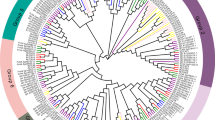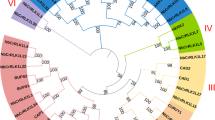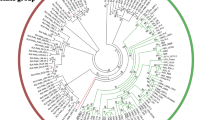Abstract
Main conclusion
A genome-wide survey of Catharanthus roseus receptor-like kinase1-like kinases (CrRLK1Ls) in rice revealed that the pattern of expression by some CrRLK1Ls is controlled by drought or circadian rhythms. This is probably accomplished through the functioning of Gigantea ( OsGI ). Such findings provide a novel angle for using CrRLK1Ls to study the drought-stress response and circadian regulation.
Abstract
The 17 CrRLK1L members of a novel RLK family have been identified in Arabidopsis. Each carries a putative extracellular carbohydrate-binding malectin-like domain. However, their roles in rice, a widely consumed staple food, are not well understood. To investigate the functions of CrRLK1Ls in rice, we utilized phylogenomics data obtained through anatomical and diurnal meta-expression analyses. This information was integrated with a large set of public microarray data within the context of the rice CrRLK1L family phylogenic tree. Chromosomal locations indicated that 3 of 16 genes were tandem-duplicated, suggesting possible functional redundancy within this family. However, integrated diurnal expression showed functional divergence between two of three genes, i.e., peak expression was detected during the day for OsCrRLK1L2, but during the night for OsCrRLK1L3. We found it interesting that OsCrRLK1L2 expression was repressed in osgigantea (osgi) mutants, which suggests that it could function downstream of OsGI. Network analysis associated with OsCrRLK1L2 and OsGI suggested a novel circadian regulation mechanism mediated by OsGI. In addition, two of five OsCrRLK1Ls preferentially expressed in the roots were stimulated by drought, suggesting a potential role for this family in water-use efficiency. This preliminary identification of CrRLK1Ls and study of their expression in rice will facilitate further functional classifications and applications in plant production.






Similar content being viewed by others
Abbreviations
- DAT:
-
Days after treatment
- GO:
-
Gene ontology
- RGAP:
-
Rice Genome Annotation Project
- RLK:
-
Receptor-like kinase
- TAIR:
-
The Arabidopsis Information Resource
References
Barrett T, Troup DB, Wilhite SE, Ledoux P, Evangelista C, Kim IF, Tomashevsky M, Marshall KA, Phillippy KH, Sherman PM (2011) NCBI GEO: archive for functional genomics data sets—10 years on. Nucleic Acids Res 39:D1005–D1010
Bartels D, Sunkar R (2005) Drought and salt tolerance in plants. Crit Rev Plant Sci 24:23–58
Boisson-Dernier A, Kessler SA, Grossniklaus U (2011) The walls have ears: the role of plant CrRLK1Ls in sensing and transducing extracellular signals. J Exp Bot 62:1581–1591
Boisson-Dernier A, Lituiev DS, Nestorova A, Franck CM, Thirugnanarajah S, Grossniklaus U (2013) ANXUR receptor-like kinases coordinate cell wall integrity with growth at the pollen tube tip via NADPH oxidases. PLoS Biol 11:e1001719
Boisson-Dernier A, Roy S, Kritsas K, Grobei MA, Jaciubek M, Schroeder JI, Grossniklaus U (2009) Disruption of the pollen-expressed FERONIA homologs ANXUR1 and ANXUR2 triggers pollen tube discharge. Development 136:3279–3288
Bolstad BM, Irizarry RA, Astrand M, Speed TP (2003) A comparison of normalization methods for high density oligonucleotide array data based on variance and bias. Bioinformatics 19:185–193
Botstein D, Cherry J, Ashburner M, Ball C, Blake J, Butler H, Davis A, Dolinski K, Dwight S, Eppig J (2000) Gene ontology: tool for the unification of biology. Nat Genet 25:25–29
Cao P, Jung K-H, Choi D, Hwang D, Zhu J, Ronald PC (2012) The rice oligonucleotide array database: an atlas of rice gene expression. Rice 5:1–9
Chandran AKN, Jung KH (2014) Resources for systems biology in rice. J Plant Biol 57:80–92
Chen ZJ (2013) Genomic and epigenetic insights into the molecular bases of heterosis. Nat Rev Genet 14:471–482
Cheung AY, Wu HM (2011) THESEUS 1, FERONIA and relatives: a family of cell wall-sensing receptor kinases? Curr Opin Plant Biol 14:632–641
Conte MG, Gaillard S, Droc G, Perin C (2008a) Phylogenomics of plant genomes: a methodology for genome-wide searches for orthologs in plants. BMC Genom 9:183
Conte MG, Gaillard S, Lanau N, Rouard M, Périn C (2008b) GreenPhylDB: a database for plant comparative genomics. Nuc Acids Res 36:D991–D998
Doi K, Izawa T, Fuse T, Yamanouchi U, Kubo T, Shimatani Z, Yano M, Yoshimura A (2004) Ehd1, a B-type response regulator in rice, confers short-day promotion of flowering and controls FT-like gene expression independently of Hd1. Genes Dev 18:926–936
Duan Q, Kita D, Li C, Cheung AY, Wu HM (2010) FERONIA receptor-like kinase regulates RHO GTPase signaling of root hair development. Proc Nat Acad Sci USA 107:17821–17826
Duan Q, Kita D, Johnson EA, Aggarwal M, Gates L, Wu H-M, Cheung AY (2014) Reactive oxygen species mediate pollen tube rupture to release sperm for fertilization in Arabidopsis. Nat Commun 5:3129
Escobar-Restrepo JM, Huck N, Kessler S, Gagliardini V, Gheyselinck J, Yang WC, Grossniklaus U (2007) The FERONIA receptor-like kinase mediates male-female interactions during pollen tube reception. Science 317:656–660
Farooq M, Wahid A, Lee D-J, Ito O, Siddique KH (2009) Advances in drought resistance of rice. Crit Rev Plant Sci 28:199–217
Fowler S, Lee K, Onouchi H, Samach A, Richardson K, Morris B, Coupland G, Putterill J (1999) GIGANTEA: a circadian clock-controlled gene that regulates photoperiodic flowering in Arabidopsis and encodes a protein with several possible membrane-spanning domains. EMBO J 18:4679–4688
Fukao T, Xiong L (2013) Genetic mechanisms conferring adaptation to submergence and drought in rice: simple or complex? Currt Opin Plant Biol 16:196–204
Goyal K, Walton L, Tunnacliffe A (2005) LEA proteins prevent protein aggregation due to water stress. Biochem J 388:151–157
Guo H, Li L, Ye H, Yu X, Algreen A, Yin Y (2009a) Three related receptor-like kinases are required for optimal cell elongation in Arabidopsis thaliana. Proc Nat Acad Sci USA 106:7648–7653
Guo H, Ye H, Li L, Yin Y (2009b) A family of receptor-like kinases are regulated by BES1 and involved in plant growth in Arabidopsis thaliana. Plant Sign Behav 4:784–786
Haruta M, Sabat G, Stecker K, Minkoff BB, Sussman MR (2014) A peptide hormone and its receptor protein kinase regulate plant cell expansion. Science 343:408–411
Hayama R, Yokoi S, Tamaki S, Yano M, Shimamoto K (2003) Adaptation of photoperiodic control pathways produces short-day flowering in rice. Nature 422:719–722
Hématy K, Sado P-E, van Tuinen A, Rochange S, Desnos T, Balzergue S, Pelletier S, Renou J-P, Höfte H (2007) A receptor-like kinase mediates the response of Arabidopsis cells to the inhibition of cellulose synthesis. Curr Biol 17:922–931
Itoh H, Izawa T (2011) A study of phytohormone biosynthetic gene expression using a circadian clock-related mutant in rice. Plant Sign Behav 6:1932–1936
Izawa T (2012) Physiological significance of the plant circadian clock in natural field conditions. Plant Cell Environ 35:1729–1741
Izawa T, Takahashi Y, Yano M (2003) Comparative biology comes into bloom: genomic and genetic comparison of flowering pathways in rice and Arabidopsis. Curr Opin Plant Biol 6:113–120
Izawa T, Mihara M, Suzuki Y, Gupta M, Itoh H, Nagano AJ, Motoyama R, Sawada Y, Yano M, Hirai MY, Makino A, Nagamura Y (2011) Os-GIGANTEA confers robust diurnal rhythms on the global transcriptome of rice in the field. Plant Cell 23:1741–1755
Jung KH, Gho HJ, Nguyen MX, Kim SR, An G (2013) Genome-wide expression analysis of HSP70 family genes in rice and identification of a cytosolic HSP70 gene highly induced under heat stress. Funct Integr Gen 13:391–402
Kessler SA, Shimosato-Asano H, Keinath NF, Wuest SE, Ingram G, Panstruga R, Grossniklaus U (2010) Conserved molecular components for pollen tube reception and fungal invasion. Science 330:968–971
Kim WY, Ali Z, Park HJ, Park SJ, Cha JY, Perez-Hormaeche J, Quintero FJ, Shin G, Kim MR, Qiang Z, Ning L, Park HC, Lee SY, Bressan RA, Pardo JM, Bohnert HJ, Yun DJ (2013) Release of SOS2 kinase from sequestration with GIGANTEA determines salt tolerance in Arabidopsis. Nat Commun 4:1352
Krakauer DC, Nowak MA (1999) Evolutionary preservation of redundant duplicated genes. Semin Cell Develop Biol 10:555–559
Lindner H, Müller LM, Boisson-Dernier A, Grossniklaus U (2012) CrRLK1L receptor-like kinases: not just another brick in the wall. Curr Opin Plant Biol 6:659–669
McClung CR (2006) Plant circadian rhythms. Plant Cell 18:792–803
Miyazaki S, Murata T, Sakurai-Ozato N, Kubo M, Demura T, Fukuda H, Hasebe M (2009) ANXUR1 and 2, sister genes to FERONIA/SIRENE, are male factors for coordinated fertilization. Curr Biol 19:1327–1331
Murashige T, Skoog F (1962) A revised medium for rapid growth and bio assays with tobacco tissue cultures. Physiol Plant 15:473–497
Ngo QA, Vogler H, Lituiev DS, Nestorova A, Grossniklaus U (2014) A calcium dialog mediated by the FERONIA signal transduction pathway controls plant sperm delivery. Develop Cell 29:491–500
Nguyen MX, Moon S, Jung KH (2013) Genome-wide expression analysis of rice aquaporin genes and development of a functional gene network mediated by aquaporin expression in roots. Planta 238:669–681
Ogiso E, Takahashi Y, Sasaki T, Yano M, Izawa T (2010) The role of casein kinase II in flowering time regulation has diversified during evolution. Plant Physiol 152:808–820
Oono Y, Yazawa T, Kawahara Y, Kanamori H, Kobayashi F, Sasaki H, Mori S, Wu J, Handa H, Itoh T (2014) Genome-wide transcriptome analysis reveals that cadmium stress signaling controls the expression of genes in drought stress signal pathways in rice. PLoS One 9:e96946
Rotman N, Rozier F, Boavida L, Dumas C, Berger F, Faure J-E (2003) Female control of male gamete delivery during fertilization in Arabidopsis thaliana. Curr Biol 13:432–436
Schulze-Muth P, Irmler S, Schröder G, Schröder J (1996) Novel type of receptor-like protein kinase from a higher plant (Catharanthus roseus). cDNA, gene, intramolecular autophosphorylation, and identification of a threonine important for auto- and substrate phosphorylation. J Biol Chem 271:26684–26689
Shinozaki K, Yamaguchi-Shinozaki K (2007) Gene networks involved in drought stress response and tolerance. J Exp Bot 58:221–227
Shiu S-H, Bleecker AB (2001) Plant receptor-like kinase gene family: diversity, function, and signaling. Sci STKE 2001:re22
Sugiyama N, Izawa T, Oikawa T, Shimamoto K (2001) Light regulation of circadian clock-controlled gene expression in rice. Plant J 26:607–615
Wong ML, Medrano JF (2005) Real-time PCR for mRNA quantitation. Biotechniques 39:75
Xiao B, Huang Y, Tang N, Xiong L (2007) Over-expression of a LEA gene in rice improves drought resistance under the field conditions. Theor App Gene 115:35–46
Yano M, Katayose Y, Ashikari M, Yamanouchi U, Monna L, Fuse T, Baba T, Yamamoto K, Umehara Y, Nagamura Y (2000) Hd1, a major photoperiod sensitivity quantitative trait locus in rice, is closely related to the Arabidopsis flowering time gene CONSTANS. Plant Cell 12:2473–2483
Yu F, Qian L, Nibau C, Duan Q, Kita D, Levasseur K, Li X, Lu C, Li H, Hou C (2012) FERONIA receptor kinase pathway suppresses abscisic acid signaling in Arabidopsis by activating ABI2 phosphatase. Proc Nat Acad Sci USA 109:14693–14698
Acknowledgments
This work was supported by the Cooperative Research Program for Agriculture Science and Technology Development (Project title: Systematic Identification of Key Genes in Rice for Increasing Yield Using Integrating Omics Technology; Project No. PJ00911002 and Project title: Construction of rice signalom network for regulating hormone biosynthesis and metabolism and the identification of the key regulator for enhancing crop yield, SSAC, Project No.PJ00951405).
Author information
Authors and Affiliations
Corresponding author
Electronic supplementary material
Below is the link to the electronic supplementary material.
425_2014_2203_MOESM1_ESM.jpg
Supplementary material 1 Fig. S1 CrRLK1L mapping on rice chromosomes. Red box indicates tandem-duplicated genes. Chromosome numbers are shown at top of each bar. (JPEG 862 kb)
425_2014_2203_MOESM2_ESM.jpg
Supplementary material 2 Fig. S2 CrRLK1L rice family phylogenomics with GO and ortholog information in Arabidopsis. Each Locus id and gene name is defined from RGAP. Pale-orange box, Group I; pale-green box,Group II; pale-yellow box, Group III. (JPEG 1373 kb)
425_2014_2203_MOESM3_ESM.jpg
Supplementary material 3 Fig. S3 Circadian expression of 17 Arabidopsis CrRLK1L members. Heat map was generated using Affymetrix Arabidopsis ATH1 genome array data sets (GSE3416) that contain expression information from 3 biological replicates of diurnal time series (4-h intervals for 24 h). Yellow, high expression; blue, low expression. (JPEG 1212 kb)
425_2014_2203_MOESM4_ESM.jpg
Supplementary material 4 Fig. S4 Effect of drought stress on morphology of WT rice. Plants were initially well-watered for 30 d, then exposed to either water-deficit or control (well-watered) conditions for 3 or 4 d. Length of white bar = 5 cm. (JPEG 3229 kb)
425_2014_2203_MOESM5_ESM.jpg
Supplementary material 5 Fig. S5 Primary structures of Arabidopsis and rice CrRLK1L family members. Proteins contain extracellular carbohydrate-binding malectin-like domain(s) (red box) and transmembrane domain (yellow box), plus protein kinase domain (blue box) that shares catalytic functions found in serine/threonine-protein kinases, tyrosine-protein kinases, and dual-specificity protein kinases. (JPEG 1772 kb)
Rights and permissions
About this article
Cite this article
Nguyen, QN., Lee, YS., Cho, LH. et al. Genome-wide identification and analysis of Catharanthus roseus RLK1-like kinases in rice. Planta 241, 603–613 (2015). https://doi.org/10.1007/s00425-014-2203-2
Received:
Accepted:
Published:
Issue Date:
DOI: https://doi.org/10.1007/s00425-014-2203-2




